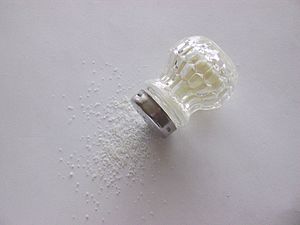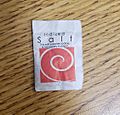Iodised salt facts for kids
Iodised salt (also called iodized salt) is regular table salt that has a tiny bit of the element iodine added to it. Eating iodine helps stop a health problem called iodine deficiency.
Around the world, about two billion people suffer from not getting enough iodine. This lack of iodine is the main cause of learning difficulties and problems with brain development that can be prevented. It can also cause issues with the thyroid gland, like a swollen neck condition called "endemic goitre." Adding small amounts of iodine to salt is a simple and cheap way to solve this big health problem in many countries.
Iodine is a very important micronutrient (a tiny amount of something your body needs) and dietary mineral. You can find it naturally in food in some places, especially near the ocean. However, iodine is quite rare in most of the Earth's soil. This is because it's a "heavy" element, and there's generally less of heavier elements in the Earth's crust. So, where the natural iodine levels in the soil are low, and plants don't get enough, adding iodine to salt makes sure people get the small but vital amount they need.
Once a package of iodised salt is opened, it can quickly lose its iodine. This happens because of a process called oxidation and iodine sublimation (where it turns into a gas without melting first).
Salt is a great way to give iodine to many people. It doesn't go bad easily, and most people eat a fairly steady amount of it. For example, in Switzerland, the amount of iodine in salt has slowly increased over the years. This has helped improve iodine levels in the general population there.
Why Iodine is So Important
As mentioned, not getting enough iodine affects two billion people globally. It's the leading cause of intellectual and developmental disabilities that can be prevented. Health experts say that adding iodine to salt might be the simplest and most cost-effective way to improve health worldwide. It costs only about US$0.05 per person each year!
At a big meeting called the World Summit for Children in 1990, a goal was set to get rid of iodine deficiency by the year 2000. Back then, only 25% of homes used iodised salt. By 2006, this number had grown to 66%.
Salt companies often support government plans to add iodine to salt. However, sometimes smaller salt makers don't like the idea because of the extra cost. Also, some people who sell iodine pills might not support it. There have also been some untrue rumors about iodisation causing illnesses.
In the United States, the Food and Drug Administration suggests that both men and women should get 150 micrograms (which is 0.15 mg) of iodine every day.
Images for kids
See also
 In Spanish: Sal yodada para niños
In Spanish: Sal yodada para niños





